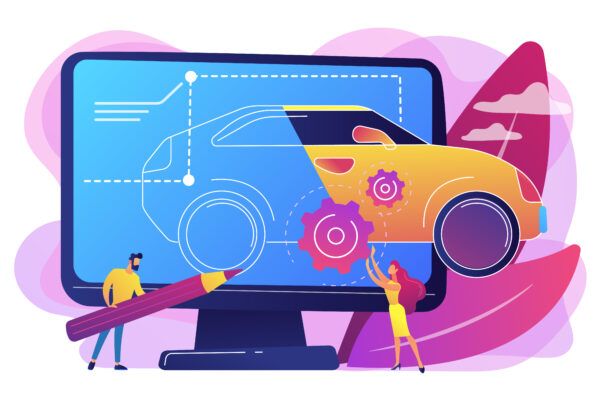Autodesk is a multinational software corporation that provides software for the architecture, engineering, construction, manufacturing, media, and entertainment industries. The company was founded in 1982 by John Walker and 12 others to develop software for the emerging personal computer market. Over the years, Autodesk has become a household name in the design and manufacturing industry, transforming how people create, design, and build things.
The Early Years
In the early days, Autodesk’s primary focus was on developing computer-aided design (CAD) software. Its first product, AutoCAD, was launched in 1982 and quickly gained popularity among architects, engineers, and designers. AutoCAD was the first CAD software to run on a personal computer, and its intuitive interface and advanced functionality made it an instant success.
In 1986, Autodesk became a publicly traded company and continued to expand its product portfolio. It acquired a number of companies, including Micro Engineering Solutions, Softdesk, and Alias, which enabled it to diversify its product offerings and expand into new markets. By the mid-1990s, Autodesk had become the world’s leading provider of CAD software, with a market share of over 70%.
Innovation and Product Development
Innovation and product development were at the core of Autodesk’s early success. The company was always looking for ways to improve its software and provide new solutions for its customers. In 1992, Autodesk introduced AutoCAD LT, a lighter version of AutoCAD that was designed for 2D drafting. This product was a game-changer for small businesses and individuals who could not afford the full version of AutoCAD. Autodesk also developed a number of other innovative products, including AutoSketch, a 2D drawing program, and Mechanical Desktop, a 3D mechanical design program. The company’s commitment to innovation and product development enabled it to stay ahead of its competitors and maintain its position as a leader in the CAD software industry.
Sustainability at Autodesk

Sustainability is a core value for Autodesk, and the company has implemented numerous initiatives to minimise its environmental impact. Autodesk is committed to achieving carbon neutrality and has reduced greenhouse gas emissions by 29% since 2009. The company encourages sustainable design practices through its software solutions and has developed tools that help architects, engineers, and designers create more environmentally friendly buildings and products. In addition, Autodesk’s offices are designed to be energy-efficient, and the company has implemented waste reduction and recycling programs. Autodesk also supports sustainability initiatives outside of the company through its philanthropic arm, the Autodesk Foundation, which funds projects that address social and environmental challenges.
Expansion and Innovation
During the late 1990s and early 2000s, Autodesk continued to expand its product portfolio and entered new markets. It acquired Discreet Logic, a company that specialised in 3D animation software and developed Maya, a powerful 3D animation software used by leading animation studios worldwide. In 2006, Autodesk made a significant move by acquiring Alias, a leading provider of 3D graphics software used in the automotive and aerospace industries.
Autodesk’s commitment to innovation and expansion continued in the following years. In 2010, it acquired BIM (Building Information Modeling) software provider Revit Technology Corporation, which allowed the company to provide comprehensive solutions for the construction industry. Autodesk also launched its cloud-based design software, Fusion 360, in 2012, which enabled users to access its design tools from anywhere and collaborate in real-time.
Autodesk Today
Today, Autodesk has a diverse portfolio of products that serve a wide range of industries. Its software solutions are used by architects, engineers, construction professionals, product designers, and media and entertainment professionals. Some of its most popular products include AutoCAD, Revit, 3ds Max, and Fusion 360. In recent years, Autodesk has also made a significant commitment to sustainability and social responsibility. The company has set ambitious goals to reduce its carbon footprint and has developed software solutions that help its customers design sustainable buildings and infrastructure.
Today, Autodesk is a leading provider of software solutions and a driving force behind innovation in the design and manufacturing industry. Autodesk’s journey from a small software company to a multinational corporation is a testament to its commitment to innovation and expansion. Over the years, the company has developed a wide range of software solutions that have transformed the way people create, design, and build things. Its commitment to sustainability and social responsibility has also set an example for other companies to follow.
Role of Autodesk in various industries
Autodesk’s software tools are used in various industries, including automotive, aerospace, construction, and manufacturing. For example, Autodesk’s software tools are used in the automotive industry to design cars and other vehicles. Engineers can use these tools to simulate the performance of a car’s engine, test different designs, and optimise the vehicle’s performance. Autodesk’s software tools are also used in the aerospace industry to design aircraft and spacecraft.
While in the construction industry, Autodesk’s software tools are used to design buildings, bridges, and other structures. Architects and engineers can use these tools to create 3D models of buildings, simulate the performance of different building materials, and test the structural integrity of a building. These tools also enable architects and engineers to collaborate more efficiently, reducing the time and cost of designing and constructing a building.
Valuation
The valuation of Autodesk is primarily based on its revenue growth potential, market share, and the overall performance of the industry it operates in. As of March 2023, Autodesk’s market capitalisation is approximately $42+ billion, and its stock has been performing well due to the increased demand for its software solutions. The company’s continued investment in research and development, expansion into new markets, and strategic acquisitions will likely influence its valuation in the future.



2 Comments
Speaking frankly, you are absolutely right.
Certainly. I join told all above.